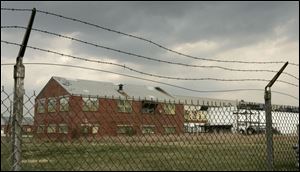
Neighbors fear delay in beryllium site cleanup
4/21/2005
Luckey s former beryllium production site is to have cleanup guidelines set by September.
LUCKEY - Like many Luckey-area residents, Steve Shaffer has waited years for the Army Corps of Engineers to begin its long-promised cleanup of a former beryllium production plant on the edge of this Wood County village.
Now, he and local officials fear time may be running out. They are concerned about rumors the property may change hands and a scrap steel recycling facility may begin operating there.
"If this site becomes another commercial industry, there would be no need for such an extensive cleanup," Mr. Shaffer wrote in a recent letter to his neighbors. "The Corps of Engineers could easily justify the less costly proposal to do little to nothing on the site since the new owners would more than likely contaminate the area again."
He is encouraging residents to contact local, state, and federal officials about their concerns for the site.
While the property has not been sold, Brad Espen, director of environmental services for the Wood County health department, said the prospect makes him nervous. He said the proposed cleanup isn't happening soon enough, and he would hate to see a new owner come in and disturb the 47-acre site.
"My big concern is this company is going to go in there and stir up the waste lagoon. If they demolish the buildings, there's beryllium dust still in the buildings," he said. "I'm concerned they'll disturb the contamination there and create a larger health and environmental problem than what's already existing."
The Atomic Energy Commission built the beryllium plant at Gilbert and Luckey roads in 1949, and it was operated by Brush Beryllium, the forerunner to the Cleveland-based Brush Wellman Inc. until 1958. The government agency shipped the beryllium pebbles to plants that made nuclear weapons.
Studies conducted by the Corps of Engineers since it became responsible for the cleanup in 1997 have shown the site is contaminated with radiological and chemical waste, including beryllium and lead.
Graham Mitchell, chief of the Office of Federal Facilities Oversight for the Ohio Environmental Protection Agency, said the current owner of the property, Hayes Lemmerz International Inc., has made the site accessible to the EPA and the Corps.
"Because the Corps does not own the site, this access issue is always a factor," Mr. Mitchell said, adding that the EPA has not been notified of any pending sale of the property.
"It's hard to imagine a current owner or a future owner of property that has contamination on it and the federal government is planning to spend their money to clean it up, why a property owner wouldn't want that to happen," he said.
Patrick Jones, a spokesman for the Corps' Buffalo district office, said the Corps plans to complete its recommendations for the cleanup of the Luckey site by the end of September, although the cleanup would not begin before 2007 because the Corps is focused on completing work at other former federal sites where cleanup is under way.
To date, the Corps has spent $14.16 million on the feasibility study and other costs related to the Luckey site, he said. The actual cleanup, which would include excavating contaminated soil and disposing of it off-site, has been estimated to cost between $136.1 million and $181.5 million.
Marika Diamond, spokesman for Hayes Lemmerz, a Northville, Mich.-based automotive wheel producer, said the company has had inquiries about the Luckey property, although it is not formally listed for sale.
She said she did not understand why residents would fear that a future owner wouldn't want to cooperate with the Corps since the government is footing the bill for the cleanup.
"If the Corps of Engineers is cleaning it up, that's a good thing for the environment at large," she said. "I don't understand why people have that concern."
Lloyd Fahle, a neighbor who worked at the beryllium plant in the 1950s, recalls burying lead filters from the plant's furnaces in the ground down to the underlying bedrock. While he too has waited patiently for the Corps of Engineers to clean up the site, he fears the contaminated material will seep into a nearby quarry that could feed into water wells.
"I'm hoping that nothing is done to it," Mr. Fahle said, referring to the possibility of a new company taking over the site. "If we've got to wait for the government to do something, then so be it. But at least nobody else is going to be in there doing anything until the contamination is taken care of."
Contact Jennifer Feehan at:
jfeehan@theblade.com
or 419-353-5972.